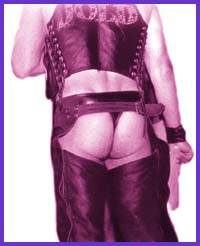The smoke from his cigar shrouded him like the early morning fog. His broad, gruff face was framed by shoulder length hair, dense and dark. The hair on his face was also thick and black, not a trace of grey. It flowed down from his beard to his thick muscled chest, encased in an open leather jacket. It continued on down his hard abs and under his leather pants.
One of the stranger’s thick paws rubbed a basket straining for release from his tight pants. Deep smouldering eyes looked at me with strength and command….
Then in bursts D’lores Delight, a six-foot-tall drag queen with two feet of hair, sporting PVC boots and a leather mini-skirt that, unfortunately, left nothing to the imagination. She starts yakking to me about someone who’s pissed her off.
So much for that erection.
Men are visual creatures: What we see helps set and maintain our moods. When we enter a leather bar, we expect a masculine, low-key atmosphere. Admittedly, not everyone is interested in this predominantly yang energy. Then again, that’s why leather bars were created.
We don’t want to force our values on other parts of the community, so we create spaces of our own. Dress codes are vital in maintaining our surroundings. Most read something like this: Leather, denim, uniform, rubber, industrial and no white sneakers. No cologne or other scents, soaps, fabric softeners that hide one’s manly scent. No dresses, no female drag or disco/designer clothes.
These standards are not set so high that the average person does not have something in their closet that meets code. Face it, most of us have a pair of jeans, a plain T-shirt and some boots or sensible shoes.
Too many people think of leatherbars as a place where people dress up in funny clothing. There are people who consider leather to be just another form of drag. That’s their interpretation. That’s their right.
To others, however, leather is about much more than dressing up. When they put on their leather, they assume a certain demeanour. Leather allows someone to release a part of themselves that generally remains hidden. Leather is primitive and aggressive. And when we go to a leather bar, we go with the intention of being around others of like disposition. Each of us contributes to the energy present. Having the dress code makes you think about your mood before entering.
And compliance to the dress code reinforces an individual’s support for the community. An individual may have patronised a leather bar for years and never worn leather. The status of that patron will increase once he starts to do so. Other patrons will support his action. They recognise the importance of what is essentially a second coming out process.
Leather is often considered a sub-culture of the gay community. In fact, it’s a culture unto itself that includes gay men, lesbians and heterosexuals. It’s also marginalized in the same manner that the gay community was 20 years ago.
Leather is often the brunt of jokes or ridicule. For instance, in a recent issue of Xtra, a photograph of a leather man is defiled by putting a woman’s head on it. Leather men were, at one time, forbidden from marching in Montreal’s Pride Day parade. And it was only in 1994 that involvement in leather and SM were, for the most part, declassified as mental illnesses.
Like gay bars, leather bars were created because the outside world can’t handle us. In the same way that gay bars chafe at heterosexual standards, leathermen chafe at “vanilla” standards. The dress code prevents tourists from parading through to get a look at the freak show.
The respect of other cultures is an important part of our community. As gay men and lesbians, we are constantly telling the straight world not to inflict its values on us, to allow us to express ourselves and develop our culture independent of mainstream values. And it’s hypocritical of gay men and lesbians to deny smaller, more marginalized cultures like leather the same treatment as we expect from the mainstream.

 Why you can trust Xtra
Why you can trust Xtra


